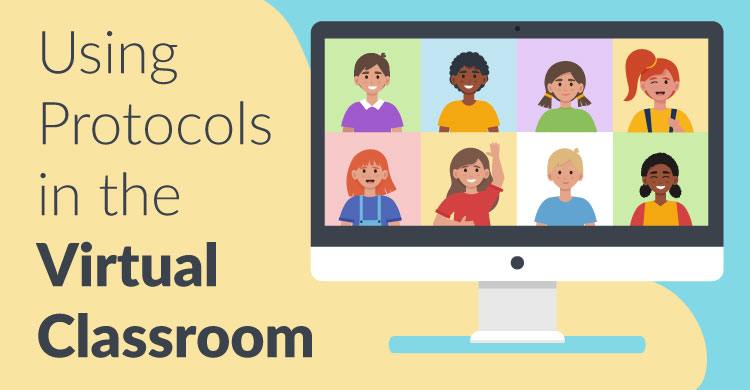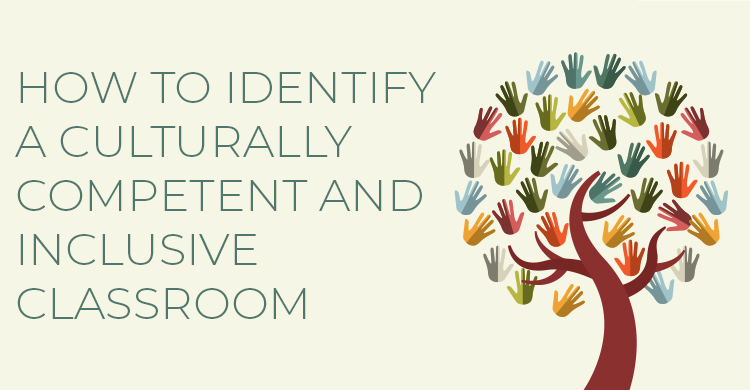There are many strategies to help facilitate the virtual learning experience. Organizing students into small groups can be a powerful learning structure to combat student isolation and increase student engagement.
But how do you ensure that putting students into breakout rooms will produce positive learning outcomes for the group and for each student? One strategy that is effective in facilitating small-group learning is using protocols.
Protocols are wonderful tools that educators can use to increase student engagement in the virtual learning environment. The word protocol is derived from the Greek word “protokollon.” The word “kollon” means glue—the glue that holds the team or group together. Protocols help students learn both the academic content standards and academic skills like collaboration, communication, critical thinking, and creativity.
Protocols are certainly not new; educators have been using protocols for the past several decades to examine student work through the use of rubrics. Since the onset of the COVID-19 pandemic, I have been using protocols to facilitate online conversations among educators that include examining professional practices, unpacking dilemmas, and looking at student work. The consensus among the educators that I have worked with is that these protocols can also be used to help students learn in the virtual classroom.
Using protocols ensures that all student voices are heard and that voices are balanced. Protocols also include critical elements for small-group work like the time to speak and listen, specific roles and steps that ensure interdependence, group and individual accountability, and processing/debriefing the learning.
The purpose of this blog post is to share a variety of protocols that educators can use to help facilitate learning in the virtual environment.
Text-Rendering Protocols
These protocols use the video breakout room feature and organize students into groups of three or four. These protocols are typically 15 to 20 minutes and require the use of a text. “Text” can be a short article, a short video, or a mini-lecture.
The Last Word
- Each student independently records three to five “ah-ha” moments or insights while reading/watching/listening to the text.
- Student A shares one insight, but does not elaborate.
- Student B and Student C discuss Student A’s insight for two minutes. Student A listens and takes notes.
- Student A has the last word for one minute.
- Rotate this process and repeat until each student has had the last word.
Say Something
- Each student independently records three to five ah-ha’s or insights while reading/watching/listening to the text.
- Student A briefly shares one insight.
- Taking turns in a round robin format, Students B and C add comments about Student A’s insight.
- Repeat until every student has shared their unique insight from the text.
Panels
- While watching the video or listening to the lecture, each student takes notes on each of the prompts listed below.
- “What I heard is …”
- “How I feel about it is …”
- “What I learned is …”
- Using their notes to answer the prompts, each student speaks for three minutes.
- Freestyle conversation about the content/process for two minutes.
The 4 A’s
- While reading/listening/watching a text, each student records their responses to the 4 A’s below (note: the teacher can provide the students with a four-quadrant graphic organizer for note-taking):
- “I agree with …”
- “I would like to argue with …”
- “The author assumes …”
- “I aspire toward …”
The Three Levels of Text
- Each student reads the assigned text and highlights sentences, phrases, and words that are significant to them.
- Round One: Each student shares a sentence that is significant to them and explains why.
- Round Two: Each student shares a phrase that is significant to them and explains why.
- Round Three: Each student shares a word that is significant to them and explains why.
- The group discusses insights about the text and the protocol.
The Jigsaw
- Divide a text into numbered parts. Number the students off based on the number of sections in the text.
- The students read their assigned section independently, highlighting big ideas and key concepts (5 minutes).
- Assign each student to breakout rooms based on the section they read (1’s, 2’s, 3’s, etc.). This will be their “expert group.” Students discuss their big ideas and takeaways and how they will teach their “home base group” their section (5 minutes).
- Regroup the students into home base groups, so that each “expert” is represented.
- Each expert shares their assigned portion of the text and teaches their group members key takeaways from the text (10 minutes).
Protocols that Facilitate a Deeper Understanding
These protocols use the breakout room feature and organize students into groups of three or four. These protocols are typically 45 to 60 minutes. These protocols are longer in duration and help students to go deeper in their learning.
Helpers Group
- One student shares an issue/dilemma and poses one question (3 minutes).
- The other students in the group ask clarifying questions (3 minutes).
- Each member of the group (except for the presenter) talks about the issue that was presented (what they heard, what they might need to know, and, what they think of the question being presented). The presenter listens and takes notes (5 minutes).
- The presenter responds to the questions while everyone else listens (3 minutes).
- The group talks openly and then closes discussion (3 minutes).
- If time allows, rotate and repeat.
Success Analysis
- Each group member is assigned a role: facilitator, timer, recorder, or summarizer.
- Each student writes down a success, making sure to answer the question, “What made this success different from other successes?” (5 minutes).
- Assign a presenter. The presenter tells his or her success in as much detail as possible. The group takes notes (3 minutes).
- The rest of the group asks clarifying questions (2 minutes).
- The group discusses what they heard the presenter say and identifies the factors that contributed to the success. The presenter takes notes and listens (3 minutes).
- The presenter reflects on the group’s discussion (2 minutes).
- Repeat the process so that each member gets to share their success.
- The group identifies and summarizes the factors that contributed to the various successes. These factors that contributed to the successes are then shared with the entire class through online tools and apps.
Tablemat
- In the main virtual room, the teacher provides all of the students with a significant word or a concept.
- Each student independently writes down what the word/concept means to them (2 minutes).
- Each group member is assigned a role: facilitator, timer, recorder, or summarizer.
- In a round-robin format, each student shares what the word/concept means to them while the other group members listen and take notes on what resonates with them.
- After everyone has shared their understanding of the word or concept, the group discusses and records what they all agree to regarding the meaning of the word/concept.
A Protocol to Close a Virtual Session
Head, Heart, Hand
- Responding to one question at a time, each student shares through the virtual chat feature or in their breakout rooms:
- Head: “What’s one thing that I will continue to think about as a result of our conversations?”
- Heart: “What’s one thing that I am feeling right now?”
- Hand: “What’s one thing that I will do as a result of our conversations?”
Helpful Tips
- Group Size: Students are randomly grouped or preassigned by the teacher into breakout rooms, with three or four students per breakout room.
- Visual Representation: Provide students with a visual, step-by-step representation of the protocol.
- Roles: Assign roles: timer, facilitator, recorder, and summarizer.
- Time: Protocols are most effective when participants adhere to the allotted time for each step.
- Online Apps: Use online apps, like padlet.com or Google Drive, to collect the groups’ input, as well as to collect student feedback (“What did our group do well today? What could we do better next time?”).
Resources:
Easton, L. B. (2009). Protocols for professional learning. Alexandria, VA: ASCD.
“Protocols.” School Reform Initiative, School Reform Initiative, www.schoolreforminitiative.org/protocols/.
Sparks-Many, Susan K., and Thomas W. Many. How to Cultivate Collaboration in a PLC. Solution Tree Press, 2015.
[author_bio id=”176″]






